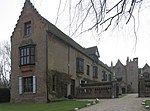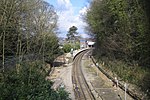Chalfont & Latimer station
Former Metropolitan and Great Central Joint Railway stationsLondon stations without latest usage statistics 1415London stations without latest usage statistics 1516London stations without latest usage statistics 1617London stations without latest usage statistics 1718 ... and 7 more
Metropolitan line stationsRail transport stations in London fare zone 8Railway stations in BuckinghamshireRailway stations in Great Britain opened in 1889Railway stations served by Chiltern RailwaysTube stations in BuckinghamshireUse British English from August 2012

Chalfont & Latimer is a London Underground and National Rail station in Travelcard Zone 8 (previously zone C) on the Metropolitan line, in Buckinghamshire. It also serves the Chiltern Railways line to Aylesbury. Chalfont & Latimer station is located just before the junction for trains to Chesham. The station serves Chalfont St Giles, Chalfont St Peter, Little Chalfont and Latimer. It is located in Little Chalfont. It opened as "Chalfont Road" on 8 July 1889 but changed to the present name from 1 November 1915. The station is a good location to alight from to explore the Chess Valley.
Excerpt from the Wikipedia article Chalfont & Latimer station (License: CC BY-SA 3.0, Authors, Images).Chalfont & Latimer station
Station Approach,
Geographical coordinates (GPS) Address Nearby Places Show on map
Geographical coordinates (GPS)
| Latitude | Longitude |
|---|---|
| N 51.6679 ° | E -0.561 ° |
Address
(indian takeaway)
Station Approach 4
HP7 9PR , Little Chalfont (Amersham and Villages Community Board)
England, United Kingdom
Open on Google Maps







